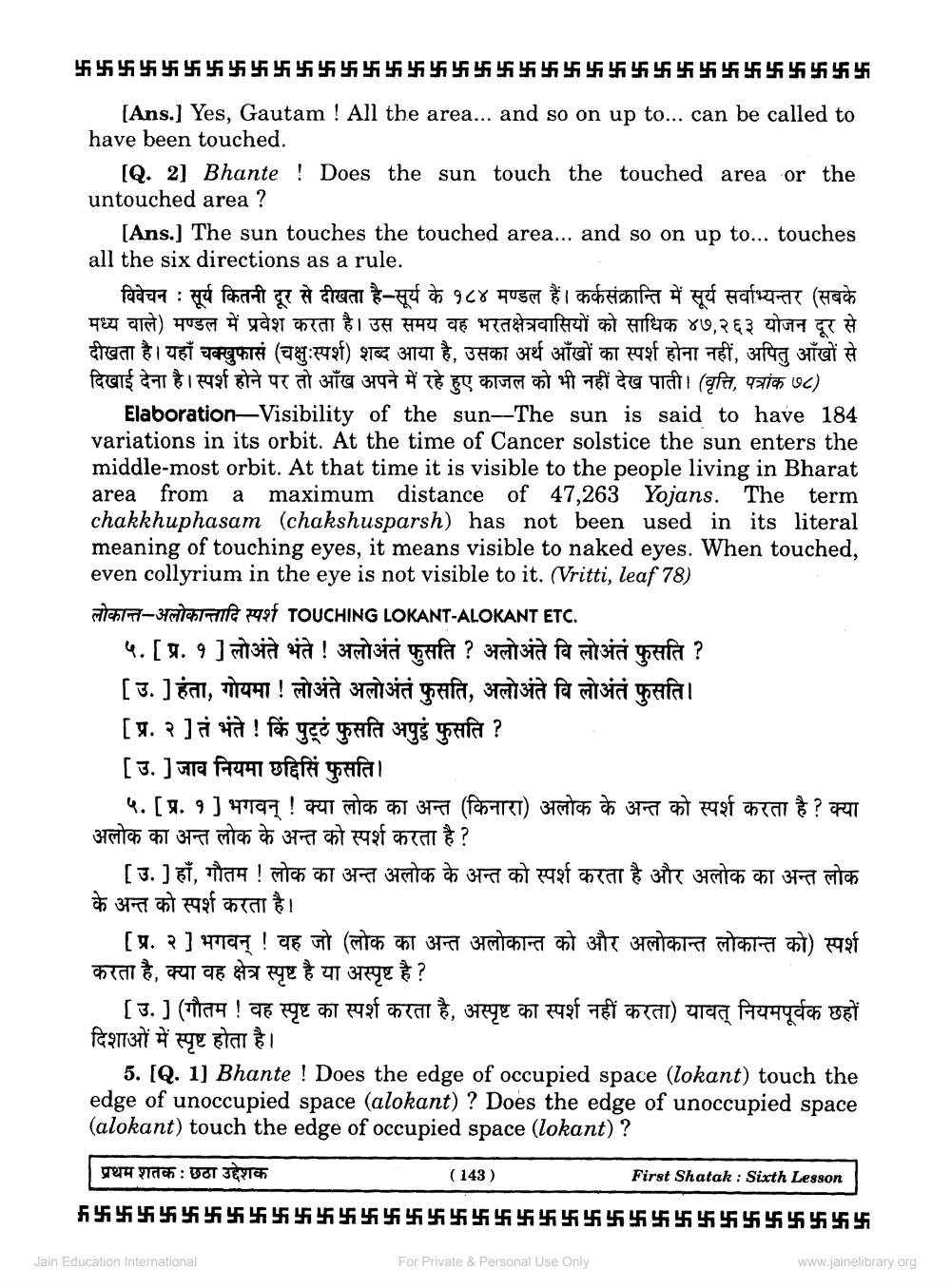________________
[Ans.] Yes, Gautam ! All the area... and so on up to ... can be called to have been touched.
[Q. 2] Bhante ! Does the sun touch the touched area untouched area ?
[Ans.] The sun touches the touched area... and so on up to... touches all the six directions as a rule.
फ्र
विवेचन : सूर्य कितनी दूर से दीखता है - सूर्य के १८४ मण्डल हैं । कर्कसंक्रान्ति में सूर्य सर्वाभ्यन्तर (सबके मध्य वाले) मण्डल में प्रवेश करता है। उस समय वह भरतक्षेत्रवासियों को साधिक ४७,२६३ योजन दूर से दीखता है। यहाँ चक्खुफासं (चक्षुः स्पर्श) शब्द आया है, उसका अर्थ आँखों का स्पर्श होना नहीं, अपितु आँखों से दिखाई देना है। स्पर्श होने पर तो आँख अपने में रहे हुए काजल को भी नहीं देख पाती । (वृत्ति, पत्रांक ७८)
लोकान्त - अलोकान्तादि स्पर्श TOUCHING LOKANT ALOKANT ETC.
५. [ प्र. १ ] लोअंते भंते ! अलोअंतं फुसति ? अलोअंते वि लोअंतं फुसति ? [उ.] हंता, गोयमा ! लोअंते अलोअंतं फुसति, अलोअंते वि लोअंतं फुसति । [प्र.२ ] तं भंते! किं पुटं फुसति अपुट्ठे फुसति ?
[ उ. ] जाव नियमा छद्दिसिं फुसति ।
Elaboration—Visibility of the sun — The sun is said to have 184 variations in its orbit. At the time of Cancer solstice the sun enters the middle-most orbit. At that time it is visible to the people living in Bharat area from a maximum_distance of 47,263 Yojans. The term chakkhuphasam (chakshusparsh) has not been used in its literal meaning of touching eyes, it means visible to naked eyes. When touched, even collyrium in the eye is not visible to it. (Vritti, leaf 78)
or the
५. [ प्र. १ ] भगवन् ! क्या लोक का अन्त ( किनारा) अलोक के अन्त को स्पर्श करता है ? क्या अलोक का अन्त लोक के अन्त को स्पर्श करता है ?
[उ.] हाँ, गौतम ! लोक का अन्त अलोक के अन्त को स्पर्श करता है और अलोक का अन्त लोक के अन्त को स्पर्श करता है।
[प्र. २ ] भगवन् ! वह जो ( लोक का अन्त अलोकान्त को और अलोकान्त लोकान्त को ) स्पर्श करता है, क्या वह क्षेत्र स्पृष्ट है या अस्पृष्ट है ?
[ उ. ] (गौतम ! वह स्पृष्ट का स्पर्श करता है, अस्पृष्ट का स्पर्श नहीं करता) यावत् नियमपूर्वक छहों दिशाओं में स्पृष्ट होता है।
Jain Education International
5. [Q. 1] Bhante ! Does the edge of occupied space (lokant) touch the edge of unoccupied space (alokant)? Does the edge of unoccupied space (alokant) touch the edge of occupied space (lokant ) ?
प्रथम शतक : छठा उद्देशक
(143)
For Private & Personal Use Only
First Shatak: Sixth Lesson
फ्र
www.jainelibrary.org




